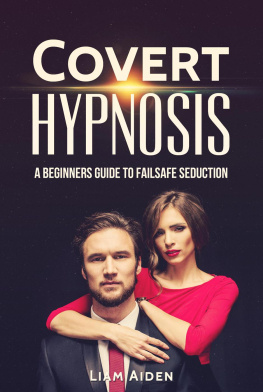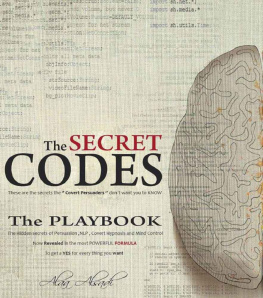Liam Aiden - Covert Hypnosis: A Beginners Guide to Failsafe Seduction
Here you can read online Liam Aiden - Covert Hypnosis: A Beginners Guide to Failsafe Seduction full text of the book (entire story) in english for free. Download pdf and epub, get meaning, cover and reviews about this ebook. year: 2019, publisher: Liam Aiden, genre: Religion. Description of the work, (preface) as well as reviews are available. Best literature library LitArk.com created for fans of good reading and offers a wide selection of genres:
Romance novel
Science fiction
Adventure
Detective
Science
History
Home and family
Prose
Art
Politics
Computer
Non-fiction
Religion
Business
Children
Humor
Choose a favorite category and find really read worthwhile books. Enjoy immersion in the world of imagination, feel the emotions of the characters or learn something new for yourself, make an fascinating discovery.
- Book:Covert Hypnosis: A Beginners Guide to Failsafe Seduction
- Author:
- Publisher:Liam Aiden
- Genre:
- Year:2019
- Rating:5 / 5
- Favourites:Add to favourites
- Your mark:
- 100
- 1
- 2
- 3
- 4
- 5
Covert Hypnosis: A Beginners Guide to Failsafe Seduction: summary, description and annotation
We offer to read an annotation, description, summary or preface (depends on what the author of the book "Covert Hypnosis: A Beginners Guide to Failsafe Seduction" wrote himself). If you haven't found the necessary information about the book — write in the comments, we will try to find it.
Liam Aiden: author's other books
Who wrote Covert Hypnosis: A Beginners Guide to Failsafe Seduction? Find out the surname, the name of the author of the book and a list of all author's works by series.
Covert Hypnosis: A Beginners Guide to Failsafe Seduction — read online for free the complete book (whole text) full work
Below is the text of the book, divided by pages. System saving the place of the last page read, allows you to conveniently read the book "Covert Hypnosis: A Beginners Guide to Failsafe Seduction" online for free, without having to search again every time where you left off. Put a bookmark, and you can go to the page where you finished reading at any time.
Font size:
Interval:
Bookmark:
While every precaution has been taken in the preparation of this book, the publisher assumes no responsibility for errors or omissions, or for damages resulting from the use of the information contained herein.
COVERT HYPNOSIS: A BEGINNERS GUIDE TO FAILSAFE SEDUCTION
First edition. February 23, 2019.
Copyright 2019 Liam Aiden.
ISBN: 978-1386207269
Written by Liam Aiden.
10 9 8 7 6 5 4 3 2 1
Covert Hypnosis
A Beginners Guide to Failsafe Seduction
 |  |


T hank you for purchasing this book Covert Hypnosis: A Beginners Guide to Failsafe Seduction. This book is designed to teach you the basics of Ericksonian speech, which is a form of hypnotic language. Throughout this book, we will teach you how to implement the speech tools into your own conversations to easily seduce women and have them wanting more from you, every time.
The purpose of Ericksonian speech is to speak to women in a way that seduces them, without being manipulative or forceful. This book emphasizes the right for women to have their ability to make any and every final decision about how they might engage with you, sexually or not. However, using the methods you learn here, you will become much better at speaking in such a way that captivates women, assists you in your pursuit, and helps them actually feel good, too. This book should make the art of seduction much easier for you, if you take the time to learn Ericksonian speech and how to effectively use it.
Within each chapter, you will learn valuable information about the way this hypnotic speech strategy works, the ethics behind it, and what it involves. You will also learn how to make it most effective, so that it will work every single time. If you do not feel confident in your ability to integrate hypnotic language into your own conversations by the last two chapters, you will find real-life examples and starter-commands to help you get started. By the time you finish reading this book, you will be confidently using Ericksonian speech to seduce women in a way youve never been able to do before.
 |  |


E ricksonian speech is the basis for this entire book, and is what is going to help you seduce women with ease. This speech method is a type of hypnotic language that is used to ultimately seduce people, or encourage them, to do nearly anything you want. While it is not true that you can literally have control over another individual, the idea is that with using a strategically formed speech strategy, you can encourage them to want to do things all on their own.
In many cases through history, books and movies have generally depicted the dark and mysterious individuals to be ones who are excellent at using hypnotic language. While these individuals are not always out to seduce others, they definitely seem to have mastered the art of Ericksonian speech in order to get their way. You see examples of this when characters speak in such a way that they are clearly commanding the other person of what to do, but the other person is still in charge of making the decision on their own. Because of this, hypnotic language is generally viewed as a sinister, dark, magical power of sorts.
To get technical, the very definition of hypnotic language is a type of speech that is designed to bring people into a hypnotic trance. To further elaborate, a trance is simply when someone is in a state of mind where they have highly focused attention. Essentially, hypnotic language is a tool people can use to have other individuals highly focused on what they are saying, and because of this, the speaker can encourage certain emotions and thoughts to occur within the listener. It is a very subtle way of telling people what to do, without actually telling them, so to speak.
There are many different types of hypnotic language tools and styles that are used nowadays. However, the belief is that the interest in the language grew exponentially alongside the growing interest in the work of Milton H. Erickson. History states that it was Erickson himself who actually pioneered this style of indirect hypnosis. Prior to Ericksons development of this indirect language, hypnosis was achieved by individuals merely telling the other person what to do, in a literal sense. So, for example, a hypnotherapist would lie their subject on a couch and then just say you are feeling sleepy, and as a result, they would expect that the subject would begin to feel sleepy. The idea was that by telling them when they were relaxed was that their subconscious mind would hear the message and agree with it. The reality, however, was that this tactic was ineffective because people do not actually like being told what to do. Direct commands to individuals was more likely to put them on edge or make them internally say no and thus reject the experience of being hypnotized. So, while this method worked on some patients, it was generally ineffective overall.
Erickson was one of the first individuals to realize that this tactic was generally ineffective, and so he began to explore new methods that would hopefully work much better. Through his studies and research, Erickson learned that listeners were failing to respond to this method because they were having a hard time matching their internal imagery to the direct orders. Therefore, it closed off their imagination and limited their ability to enter any form of hypnotic state. After learning this Erickson started searching for new ways to lead individuals into a hypnotic trance in a way that would work effectively.
Through his research, Erickson discovered that the best way to lead people into this hypnotic state was to encourage them to create the images on their own terms. In order to do so, the speaker or guide must speak in such a way that creates the foundation for specific thoughts and emotions, but does not actually specifically tell the other individual to think or feel any specific emotion. If there were a particular emotion someone was trying to get another to feel, they would question whether or not the listener was feeling it, not outright tell the listener to feel it. This way, the listener would become curious about the emotion and explore them on their own, rather than shut down from being given a direct order.
So, in essence, Ericksonian speech is a completely permissive type of language that speakers can use to lead others to a certain frame of mind. Instead of directly saying what you want from someone, or what you want them to think or feel, you guide them in that direction. Then, because you are not literally telling them what you want them to think or feel, their mind will go in the exact direction they want it to go in. That means you are not actually manipulating their thoughts or putting things into their head that arent their own. Instead, you are encouraging them to explore feelings and thoughts that are already there, and hoping that the outcome will match your desires. This is important when it comes to seduction, because it helps guide the conversation effectively, while also avoiding the listener from feeling like she is being manipulated into thinking something.
Font size:
Interval:
Bookmark:
Similar books «Covert Hypnosis: A Beginners Guide to Failsafe Seduction»
Look at similar books to Covert Hypnosis: A Beginners Guide to Failsafe Seduction. We have selected literature similar in name and meaning in the hope of providing readers with more options to find new, interesting, not yet read works.
Discussion, reviews of the book Covert Hypnosis: A Beginners Guide to Failsafe Seduction and just readers' own opinions. Leave your comments, write what you think about the work, its meaning or the main characters. Specify what exactly you liked and what you didn't like, and why you think so.









